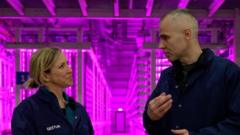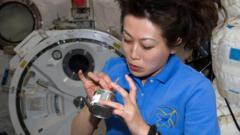In the stunning landscape of Iceland, a futuristic algae farm is redefining food production. Vaxa Technologies has set up its unique facility near the largest geothermal power station in the country, which is instrumental in nurturing a new wave of sustainable food sources. Under the mesmerizing glow of pink and purple lights, microalgae thrive amidst a technologically advanced environment.
Kristinn Haflidason, general manager of Vaxa, explains that while seaweed has long been part of human diets, microalgae are now gaining attention for their rich nutritional content. The farm cultivates two key organisms: Nannochloropsis, a type of microalgae used as food for humans and feed for aquaculture, and Arthospira (spirulina), known for its dietary benefits and vibrant color.
This innovative operation stands out because it integrates perfectly with Iceland's geothermal power. It leverages clean energy, cold water for cultivation, hot water for heating, and captures CO2 emissions, creating a sustainable cycle. Researchers have found that Vaxa exhibits a notable carbon-negative footprint, making its process environmentally friendly and resource-efficient.
At the heart of the facility are advanced photo-bioreactors, where microalgae flourish under artificial red and blue light. This setup allows for optimized growth conditions, driven by machine learning algorithms to ensure maximum efficiency. Vaxa cultivates approximately 150 metric tonnes of microalgae annually, with ambitions to scale up production, potentially influencing global food security due to the richness of the crops.
The microalgae market is booming, with estimates projecting a value of $25.4 billion by 2033. Companies like Danish start-up Algiecel are exploring mobile solutions that link to carbon-emitting sectors while producing edible algae. Microalgae applications are also diversifying into industries like cosmetics, pharmaceuticals, and even biofuels.
Despite the promising potential, there remains skepticism about mainstream adoption of microalgae. Texture and flavor present challenges that need addressing before it can become a staple in our diets. Nevertheless, experts like Malene Lihme Olsen advocate for incorporating microalgae into familiar products to improve palatability and showcase its nutritional benefits.
While the harvested green sludge may not look appealing, it serves as a supplement rather than a standalone food. Vaxa aims to enhance existing foods' nutritional profiles rather than overhaul culinary traditions. Haflidason emphasizes, “We're just going to change the nutritional value of the foods that you eat.”
As the world continues to look for sustainable solutions in food production, Iceland's algae farm exemplifies how driving innovation and utilizing natural resources can pave the way for food security and healthier diets globally.
Kristinn Haflidason, general manager of Vaxa, explains that while seaweed has long been part of human diets, microalgae are now gaining attention for their rich nutritional content. The farm cultivates two key organisms: Nannochloropsis, a type of microalgae used as food for humans and feed for aquaculture, and Arthospira (spirulina), known for its dietary benefits and vibrant color.
This innovative operation stands out because it integrates perfectly with Iceland's geothermal power. It leverages clean energy, cold water for cultivation, hot water for heating, and captures CO2 emissions, creating a sustainable cycle. Researchers have found that Vaxa exhibits a notable carbon-negative footprint, making its process environmentally friendly and resource-efficient.
At the heart of the facility are advanced photo-bioreactors, where microalgae flourish under artificial red and blue light. This setup allows for optimized growth conditions, driven by machine learning algorithms to ensure maximum efficiency. Vaxa cultivates approximately 150 metric tonnes of microalgae annually, with ambitions to scale up production, potentially influencing global food security due to the richness of the crops.
The microalgae market is booming, with estimates projecting a value of $25.4 billion by 2033. Companies like Danish start-up Algiecel are exploring mobile solutions that link to carbon-emitting sectors while producing edible algae. Microalgae applications are also diversifying into industries like cosmetics, pharmaceuticals, and even biofuels.
Despite the promising potential, there remains skepticism about mainstream adoption of microalgae. Texture and flavor present challenges that need addressing before it can become a staple in our diets. Nevertheless, experts like Malene Lihme Olsen advocate for incorporating microalgae into familiar products to improve palatability and showcase its nutritional benefits.
While the harvested green sludge may not look appealing, it serves as a supplement rather than a standalone food. Vaxa aims to enhance existing foods' nutritional profiles rather than overhaul culinary traditions. Haflidason emphasizes, “We're just going to change the nutritional value of the foods that you eat.”
As the world continues to look for sustainable solutions in food production, Iceland's algae farm exemplifies how driving innovation and utilizing natural resources can pave the way for food security and healthier diets globally.





















